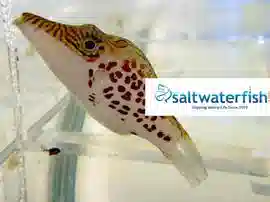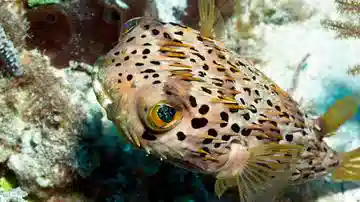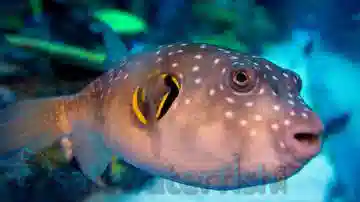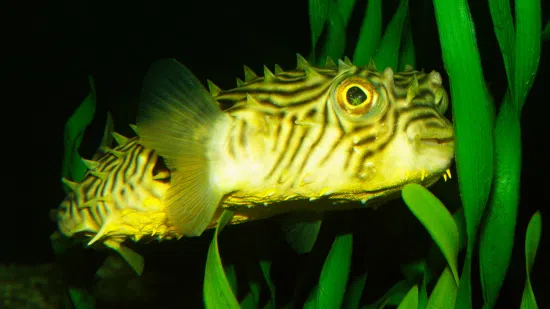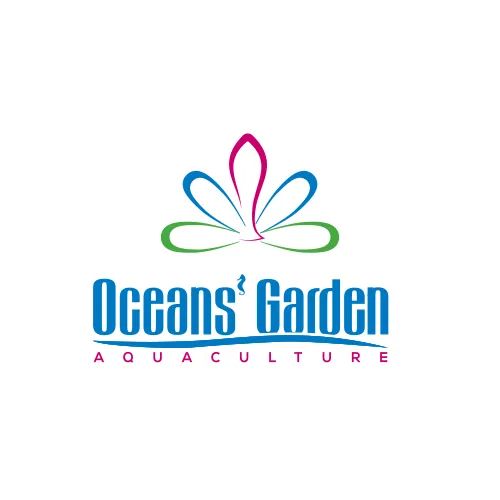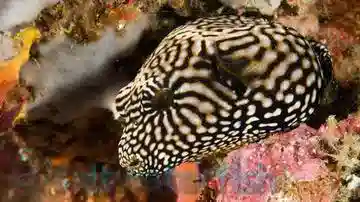Map Puffer
Arothron mappa
(2 Reviews)
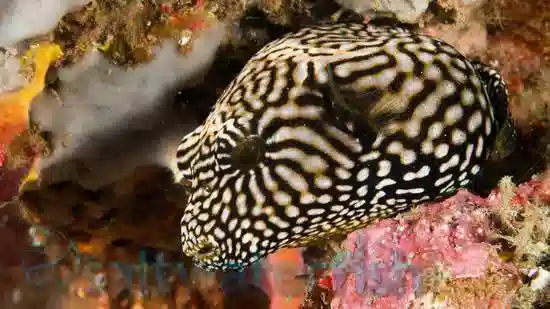
Map Puffer
Arothron mappa
(2 Reviews)
{{ item.name }}
Size: {{ item.extra_field_3 }}
${{ getFormattedPrice(item.saleprice) }} ${{ getFormattedPrice(item.price) }}
To join the waiting list, click here
Free Shipping
With
$199.00
or more in Marine Life.
More details...
Map Puffer Care Facts
| Care Level: | Easy |
|---|---|
| Temperament: | Semi-Aggressive |
| Diet: | Carnivore |
| Reef Safe: | No |
| Minimum Tank Size: | 300 gallons |
| Max Size: | 25 inches |
Map Puffer (Arothron mappa) - A Comprehensive Guide for Saltwater Marine Aquariums
This comprehensive guide offers valuable insights into the care and maintenance of the Map Puffer (Arothron mappa) in saltwater marine aquariums. Covering various aspects of this species, including its habitat, reef compatibility, size, lifespan, dietary needs in captivity, aquaculture availability, sexual dimorphism, symbiotic relationships, juvenile versus adult coloration, temperament, tank requirements, and specific water conditions, it aims to assist both beginners and experienced aquarists in successfully keeping and appreciating these captivating fish in their aquariums.
Habitat of the Map Puffer (Arothron mappa):
The Map Puffer, scientifically known as Arothron mappa, is commonly found in the Indo-Pacific region, particularly in the waters of the Indian Ocean and the western Pacific Ocean. They prefer a habitat of coral reefs, lagoons, and shallow coastal waters with a sandy substrate. These puffers are characterized by their unique coloration and intricate map-like patterns that cover their bodies.
Reef Compatibility of the Map Puffer:
The Map Puffer is not considered reef-safe due to its diet and natural foraging behavior. They have strong jaws and a propensity for nipping at corals and other invertebrates, which can damage a reef tank. Therefore, it is recommended to keep Map Puffers in a fish-only or FOWLR (Fish Only With Live Rock) setup rather than a reef tank.
Size of the Map Puffer:
Map Puffers can grow substantially, reaching lengths up to 15 inches (38 centimeters) when fully mature. Their potential size is crucial when planning your aquarium setup, as they require ample swimming space.
Lifespan of the Map Puffer:
With proper care and a suitable environment, Map Puffers can live relatively long in captivity, often for 10 to 15 years or more. This longevity makes them a rewarding addition to marine aquariums.
Diet in Captivity:
Map Puffers are carnivorous and have a voracious appetite. In captivity, their diet should primarily consist of:
- High-quality frozen seafood such as shrimp, squid, and fish.
- Occasionally, offer live or frozen crustaceans like crabs and shrimp.
- Provide occasional treats of mollusks and clams in their shell, which help naturally wear down their constantly growing teeth.
Aquaculture Availability:
Map Puffers are not available through aquaculture efforts, and most specimens in the aquarium trade are wild-caught. Purchasing Map Puffers from reputable suppliers who adhere to ethical and sustainable collection practices is essential to minimize the impact on wild populations.
Sexual Dimorphism:
Map Puffers do not exhibit significant sexual dimorphism, and distinguishing between males and females based on physical characteristics can be challenging.
Symbiotic Relationships of the Map Puffer
Map Puffers may establish symbiotic relationships with cleaner fish and shrimp in their natural habitat. Cleaner fish and shrimp help keep the puffer's skin free of parasites by feeding on them. However, replicating this relationship in captivity can be challenging, and compatibility with cleaner species should be cautiously approached.
Juvenile vs. Adult Coloration of the Map Puffer
Juvenile Map Puffers often display more vivid colors and intricate patterns than their adult counterparts. As they mature, the intensity of their patterns may diminish, and their coloration can become more subdued.
Compatibility of the Map Puffer
Compatibility with other tank inhabitants is crucial for maintaining a harmonious environment when considering a Map Puffer for your saltwater aquarium.
Temperament of the Map Puffer:
Map Puffers are known for their curious and somewhat territorial nature. While they can be kept with other fish, carefully selecting tank mates and adequate space are essential to prevent aggression.
Suitable Tank Mates for the Map Puffer
Here are five compatible tank mates that can coexist peacefully with Map Puffers:
- Lionfish (Pterois spp.): Lionfish are typically slow-moving and can coexist with Map Puffers if they are not overly aggressive.
- Triggerfish (Balistidae): Certain triggerfish species, like the Picasso Triggerfish (Rhinecanthus aculeatus), can be compatible if the tank size permits.
- Tangs (Acanthuridae): Larger tang species may work well as tank mates but ensure enough space and hiding spots to reduce territorial behavior.
- Large Angelfish (Pomacanthidae): Some larger angelfish species can be suitable tank mates if adequately acclimated and introduced.
- Butterflyfish (Chaetodontidae): Some butterflyfish species may coexist with Map Puffers if they are similar in size and temperament.
Tank Requirements for the Map Puffer
Creating an ideal environment is crucial for the well-being of Map Puffers. Here are some essential tank requirements:
- Minimum Tank Size: A tank with a capacity of at least 300 gallons is recommended to provide ample swimming and hiding space for a fully grown Map Puffer.
- Substrate: Use a fine, sandy substrate to create a natural environment and prevent abrasion to their delicate skin.
- Aquascaping: Incorporate live rock structures to provide hiding spots and visually appealing environments.
- Water Conditions: Maintain stable water conditions within the following parameters:
- pH: Keep the pH level between 8.1 and 8.4.
- Salinity: Maintain a salinity level between 1.024 and 1.026.
- Water Temperature: Keep the water temperature in the range of 74°F to 78°F (23°C to 26°C).
- Water Flow: Provide moderate flow, as Map Puffers prefer areas with gentle to mild currents.
Other Common Names for the Map Puffer
The Map Puffer is also known as the Mappa Puffer.
Why People Should Buy the Map Puffer from Saltwaterfish.com:
When considering the purchase of a Map Puffer, sourcing it from reputable suppliers like Saltwaterfish.com ensures the highest quality and ethical standards. These suppliers prioritize the well-being of the fish and employ sustainable practices that protect natural marine ecosystems. Purchasing from such sources benefits the aquarium and contributes to marine life conservation.
In conclusion, the Map Puffer is a captivating addition to saltwater marine aquariums, known for its intricate patterns and engaging behavior. By adhering to the guidelines outlined in this comprehensive guide and sourcing these puffers from ethical suppliers, aquarists can enjoy the presence of this remarkable species while promoting responsible and sustainable practices within the hobby.
Perfect!
Reviewed by: Neil Tournoux on Jan. 1, 2024
I bought this Map Puffer here and to show you how hardy this guy is, he was the most active of 5 fish I had delivered when outside temp in MN was 21 degree out and bag water was at 68 degrees. All survived after 2 1/2 hr slow drip acclimation. He is a colorful little guy to watch darting around the tank. He is constantly on the move searching for food or detritus on the bottom as well as on reef rock. Likes to dart in and out of rock. He is getting much better at snagging Mysis shrimp I drop in before the other 6 fish hog it all, especially my Hamlet Indigo who gobbles everything that moves. A joy to watch.
Reviewed by: Philip Brock on Dec. 31, 2021


